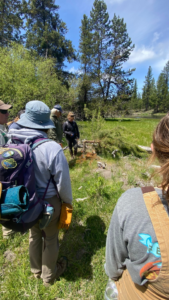Beaver Habitat Planting at La Pine State Park
Beaver Habitat Planting at La Pine State Park
In the summer of 2023, Beaver Works Oregon conducted a site assessment at LaPine State Park for the Planting BeaverHOOD habitat restoration project. LaPine State Park sits along a section of the Deschutes River within the National System of Wild and Scenic Rivers and is known to host Oregon’s largest Ponderosa Pine, thought to be more than 500 years old. The site showed high potential for habitat improvement. There were plenty of historic beaver signs (i.e. beaver chews), indicating beavers had occupied the area, perhaps when the riparian habitat was in better shape. At the time of assessment, the habitat appeared denuded, evidenced by sparse growth of shrubs and sub-shrubs, and compacted vegetation from use as an undesignated trail. Plans to restore 1200 native willow plants at one site just downstream of Dead Slough on the South bank of the Deschutes River in the spring of 2024 were set in action.




Native riparian hardwood plants, staples of the beaver diet and their essential building resources, were harvested in the early spring of 2024. Over 30 volunteers helped collect 5,180 sticks, which were in cold storage until the planting events began.
Ten volunteers helped execute the planting at La Pine State Park on May 28th and 29th. The team carted supplies to the sites along the river, including metal stakes and mallets for drilling holes into the ground, fencing material, and, of course, the sticks, and set to work! By the end of the second day, 1108 willow and nine dogwood sticks were trimmed, planted, and fenced within four different plots.
Like much of the East Cascades, the resident community wrestles with fire safety and recreational use and development increases. There are beaver sightings and beaver signs within La Pine State Park along the ma
Community Engagement Through Monitoring
 Plant survival and growth will be monitored throughout the year, using the same protocol we use at our other restoration projects, by Oregon State Parks staff for three years. Trail cameras are also set up to capture footage of wildlife near the sites and will be posted here. Additionally, a chronolog post (a photo station that allows any passersby to capture and upload identical photos of the site) was installed to create a timelapse of the site over time. We’re excited to join the over 600 monitoring projects by inviting park visitors in to learn and contribute to the beaver-focused riparian restoration project.
Plant survival and growth will be monitored throughout the year, using the same protocol we use at our other restoration projects, by Oregon State Parks staff for three years. Trail cameras are also set up to capture footage of wildlife near the sites and will be posted here. Additionally, a chronolog post (a photo station that allows any passersby to capture and upload identical photos of the site) was installed to create a timelapse of the site over time. We’re excited to join the over 600 monitoring projects by inviting park visitors in to learn and contribute to the beaver-focused riparian restoration project.

